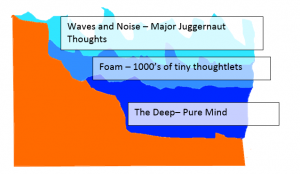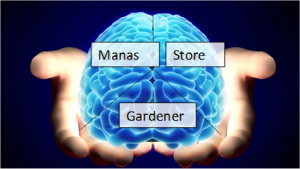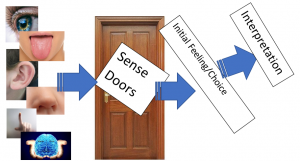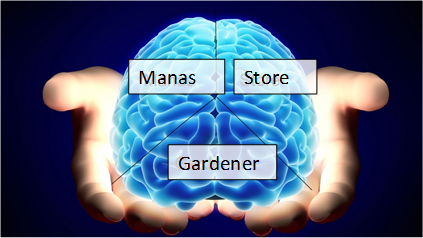This post takes you through some of the fundamental understandings of Buddhist Psychology.
Here the audio here or read the post below.
In Buddhist meditation we practise 3 main types of meditation. It’s worth stating that ALL have sitting beneath them mindfulness.
They are
Samadhi – Simply put this means the development of concentration.
Vipassana – The development of Insight or Wisdom.
Metta Bhavanna – Cultivation of compassion or loving kindness
All involve mindfulness and all therefore require us to come to terms with and understand our own minds.
So lets take a look at the nature of mind. Note that we are talking about mind here, rather than brain. The brain is the physical container. We need to understand the nature of mind and for this we use some visuals and images.
Firstly, we can view the mind as having layers and you will certainly discover the top two layers relatively quickly in your meditation. These layers are analogous to the sea.
 The top layer is the very noisy layer with waves crashing and debris floating around there. This is a noisy, chaotic place. Here, in the mind we have our main thoughts passing through. What I call the ‘juggernaut’ thoughts. They have real substance and we normally latch on to them and believe they serve a purpose. Whether they do or not is to be discovered. For now, just seeing that they are there is enough. In meditation, we try to stay outside of the story of the thoughts. Just seeing them for what they are.
The top layer is the very noisy layer with waves crashing and debris floating around there. This is a noisy, chaotic place. Here, in the mind we have our main thoughts passing through. What I call the ‘juggernaut’ thoughts. They have real substance and we normally latch on to them and believe they serve a purpose. Whether they do or not is to be discovered. For now, just seeing that they are there is enough. In meditation, we try to stay outside of the story of the thoughts. Just seeing them for what they are.
Below this is a fascinating layer. Just below the waves is a layer of foam. In our minds we have a layer like this. It is full of thousands of tiny thoughtlets all kicking off. Snippets of conversations, memories of faces, little bits of music. All firing off continuously. This is a real place to study and can tell us a great deal about our subconscious mind if we tune in to it.
Then we have the deep dark ocean, and this is pure mind. Sometimes we access this in meditation. It is always there, and the two layers are always above.
This IS the way mind is. We have to accept the noisy chaotic nature of mind to allow us to progress with meditation and access the peace of that deeper part of the mind.
In order to allow us to view the mind in this way, we need to understand how mindfulness is even possible.
 There are 3 parts to Mind. The first, we call Manas (The Pali word for mind). This is the part that carries out our thinking, worrying, planning etc and the part that we are most familiar with. The second is our store consciousness and it is on this that the Manas acts. Essentially this is analogous to memory but it is greater than that as it stores all of our prejudices, religious, phobias etc. Anything that can be stored, is held in here.
There are 3 parts to Mind. The first, we call Manas (The Pali word for mind). This is the part that carries out our thinking, worrying, planning etc and the part that we are most familiar with. The second is our store consciousness and it is on this that the Manas acts. Essentially this is analogous to memory but it is greater than that as it stores all of our prejudices, religious, phobias etc. Anything that can be stored, is held in here.
Finally we have what we call the gardener. This is the remarkable bit. This is the part of the mind that is able to watch the other two parts working together. It is a pure observer. This, we get in touch with in meditation.
To then take things forward we can start to see, through the application of mindfulness how the mind works. Over the weeks we do delve into these areas deeply but for now we can see what happens with our experience.
To understand this we must see that we have our main five senses but we have a sixth; the mind. Just as the other senses have triggers, so does the mind. For example, a particle enters the nose and triggers the sense of smell. In just the same way, a though enters our heads and triggers the sense of ‘mind’.
Buddhist psychology constructs a view of how our senses interact with the world around us and allow us to understand and experience our world in the way we do.
 We need to understand that this isn’t a scientific model. It is an experiential one. The early followers of the Buddha used introspection and mindfulness to understand how we work and effectively drew this picture of how the mind works. After all, knowing which bits of the brain fire up is, without doubt, interesting but it doesn’t really help us understand our experience of mind.
We need to understand that this isn’t a scientific model. It is an experiential one. The early followers of the Buddha used introspection and mindfulness to understand how we work and effectively drew this picture of how the mind works. After all, knowing which bits of the brain fire up is, without doubt, interesting but it doesn’t really help us understand our experience of mind.
When a trigger touches one of our sense organs, the first thing that happens is that they touch the sense doors and this is the contact with mind. At this stage the experience is usually unconscious. It is pure experience of the sense.
Next the mind creates an initial feeling or impression of the sense. This is a very complex process, driven by our past history of the particular sensory input. We call this Vedanas and this is a detailed topic for another day. The moment, we can simply watch how the mind very quickly decides whether it likes or dislikes a particular sensory object.
Then the mind really kicks in! The process of interpretation. The mind spins off and embellishes the experience, draws conclusions and potentially produces emotional reaction.
All of this is an amazing process to watch. What is really phenomenal, the more you get in to this, is that the mind is of course one of these senses. The thoughts drifting through the mind are the triggers. So all of these stages that we have just looked at, we can also see happening with thoughts themselves!
So for our meditation today, we will use the mindfulness of breathing and examine the first two layers of mind, the waves and the foam!

